The Nikon 180-400mm f/4E TC1.4 FL ED VR is a professional-grade super-telephoto zoom lens designed for sports and wildlife photographers. Its predecessor, the Nikon 200-400mm f/4G ED VR II, was a very popular lens for many years among many action photographers. When Canon released its 200-400mm f/4L IS USM with a built-in 1.4x teleconverter, many Nikon shooters wondered if such a lens could materialize for them in the future. Nikon finally announced the updated version in January of 2018, pushing the optical design even further by incorporating a built-in 1.4x teleconverter, as well as expanding the zoom range by 20mm on the short end. In this review, we will take a closer look at this amazingly versatile lens and compare it to its predecessor.
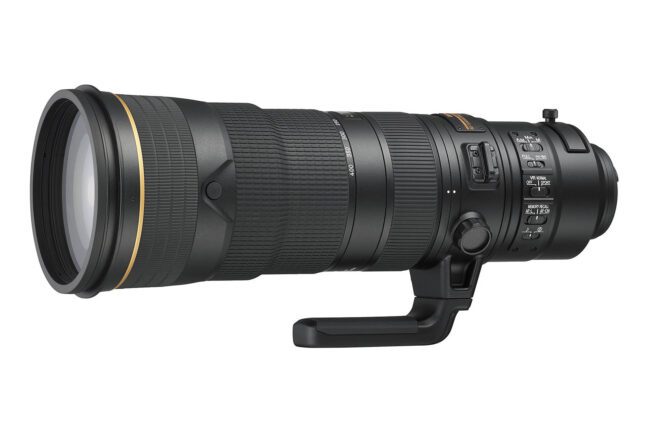
Nikon 180-400mm f/4E TC1.4 FL ED VR Overview
If you have ever been on an African safari, you know how difficult it can get to frame wildlife with super-telephoto prime lenses. Often times, you are left wishing you had a longer lens to capture the action, but sometimes you wish you had a shorter lens because the action is too close to the vehicle. So you are often left with tough choices, such as extensive cropping in post, or focusing on a particular body part of the animal.

NIKON D850 + 180-400mm f/4 @ 400mm, ISO 220, 1/1250, f/4.0
The same goes for shooting sports like football, soccer, and hockey, where you are only allowed to shoot from a certain position, but the action takes place at different distances. As athletes run from one side of the field to the other, being able to quickly change the framing without needing to swap cameras and lenses gives you a much higher chance of getting the “winning shot”.
Without a doubt, high-end prime lenses are amazing, but they lack the versatility of zoom lenses for shooting action at varying distances. For such situations, a high-end zoom lens like the 180-400mm is going to quickly prove to be indispensable.
At $12,399 MSRP, the Nikon 180-400mm f/4E TC1.4 FL ED VR is one of the most expensive Nikon lenses ever produced. It is the second most expensive lens in the current line-up after the AF-S 800mm f/5.6E FL ED VR monster. While many photographers would immediately dismiss this lens due to its high price tag, let’s not forget that this is a very specialized lens that is designed for professionals in the field. For everyone else, there are much cheaper alternatives available in the form of lenses like the Nikon 200-500mm f/5.6E ED VR.

NIKON D850 + 180-400mm f/4 @ 180mm, ISO 320, 1/2000, f/5.6
Lens releases like the 180-400mm f/4E are very rare in the photography world. We see camera and lens announcements practically every month, but true high-level innovations are not easy to bring out due to the amount of time, effort, and resources that are required to make it all happen. That’s why top-of-the-line super-telephoto lenses are expensive, as they require many years of engineering and testing in the field.
With professionals using and abusing their gear in the field, manufacturers have to pay extreme attention to every bit of detail to make sure that their products are able to function reliably over a long span of time, in any conditions. Companies like Nikon and Canon know that their clients choose their systems because of a vast selection of high-end options, which is why exotic lenses are never rushed into the market. Meticulous precision, careful hand assembly, thorough testing, and high attention to detail are critical to making high-end lenses function without any issues in the field, which is why we rarely ever see lens variation in exotic super-telephoto lenses. Having tested a number of such lenses both in the field and in my lab, I have to admit that I have not come across a bad lens sample, which is something that happens very often when I test standard lenses.

NIKON D850 + 180-400mm f/4 @ 220mm, ISO 450, 1/2000, f/4.0
Nikon 180-400mm f/4E TC1.4 FL ED VR Specifications
- Mount Type: Nikon F-Bayonet
- Focal Length: 180-400mm
- Maximum Aperture: f/4 (f/5.6 with built-in TC)
- Minimum Aperture: f/32 (f/45 with built-in TC)
- Angle of View (DX-format): 4°-9° (2°50′-6°20′ with built-in TC)
- Angle of View (FX-format): 6°10′-13°40′ (4°30′-9°50’with built-in TC)
- Maximum Reproduction Ratio: 0.25x (at 400mm), 0.36x (at 560mm)
- Lens Elements / Groups: 27 / 19
- VR (Vibration Reduction) Image Stabilization: Yes
- Diaphragm Blades: 9 (Rounded)
- Diaphragm Type: Electronic
- Fluorite Elements: 1
- ED Glass Elements: 8
- Nano Crystal Coat: Yes
- Super Integrated Coating: Yes
- Autofocus: AF-S (Silent Wave Motor)
- Internal Focusing: Yes
- Minimum Focus Distance: 6.6 ft. (2.0 m)
- Filter Size: 40.5mm
- Accepts Filter Type: Slip-in
- Compatible with Nikon AF-S Teleconverters: Yes
- Dimensions: 5.0 in. (128.0 mm) x 14.2 in. (362.5 mm)
- Weight: 123.4 oz. (3,500 g)
Detailed specifications for the lens, along with other useful data can be found on the Nikon AF-S NIKKOR 180-400mm f/4E TC1.4 FL ED VR page of our lens database.

NIKON D850 + 250-550mm f/5.6 @ 550mm, ISO 450, 1/250, f/5.6
Let’s take a look at what has changed since the 200-400mm f/4G ED VR II.
Nikon 180-400mm f/4E VR vs Nikon 200-400mm f/4G VR II
To make the 180-400mm f/4E a stellar lens in terms of performance, Nikon went with a completely different optical design to yield the best performance. Because of this, we can see a noticeable difference in the total number of lens elements (27 vs 24), as well as in the number of extra-low dispersion elements (8 vs 4).
Due to the use of a fluorite lens element, Nikon was able to shave off a large lens element from the front of the lens, which makes the lens much more balanced to hand-hold compared to its predecessor – it is no longer as front-heavy as the 200-400mm f/4G VR II. Take a look at the new lens construction of the 180-400mm lens and feel free to compare it to the one on the 200-400mm:
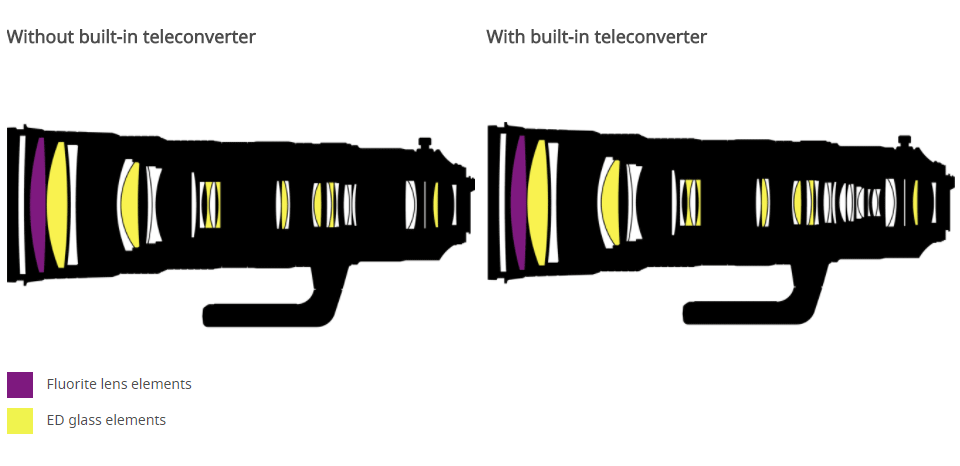
The addition of the built-in teleconverter adds a total of 8 more glass elements, as well as more metal on the side of the lens to be able to switch the teleconverter on and off, which obviously increases the overall weight of the lens. However, due to the addition of the fluorite lens element, Nikon was able to keep weight under control – the new 180-400mm f/4 is only 140 grams heavier compared to its predecessor, which is not noticeable at all when hand-holding.
Lastly, let’s not forget about the benefits of all the new technology and optical coatings that Nikon was able to incorporate to the 180-400mm. In addition to Nano and Super Integrated coatings, the front of the lens is also fluorine-coated in order to repel water, dust, dirt, and other environmental elements. The electronic diaphragm also yields very high exposure accuracy when shooting in bursts. Lastly, the AF performance of the 180-400mm is superior in both autofocus speed and accuracy, especially when using the built-in 1.4x teleconverter (vs attaching a 1.4x teleconverter to the 200-400mm f/4G ED VR II).
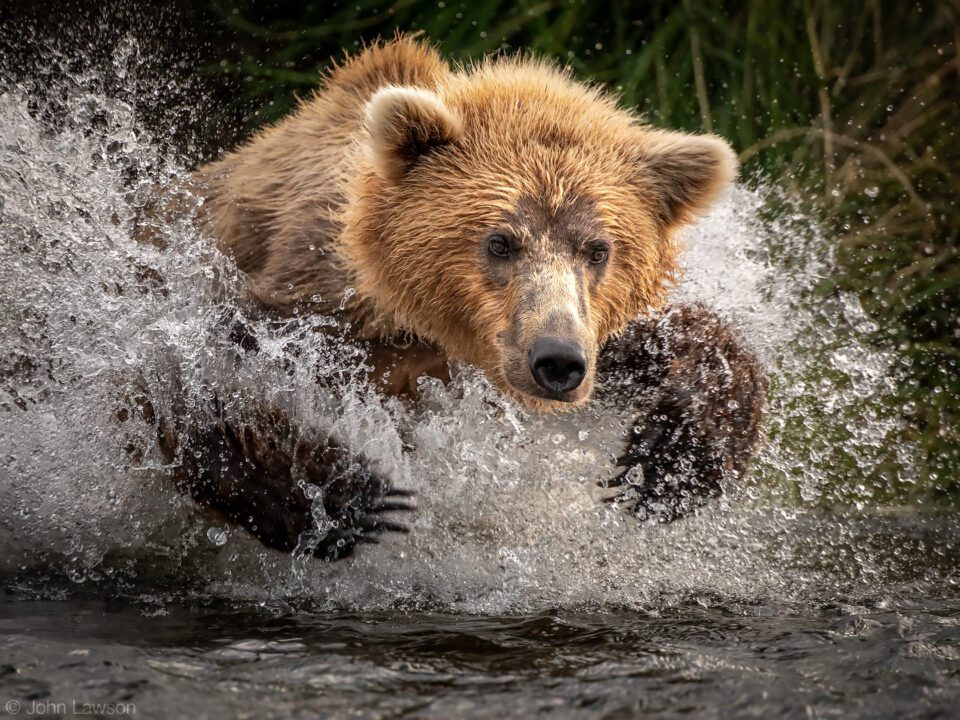
NIKON D850 + 180-400mm f/4 @ 380mm, ISO 400, 1/1000, f/4.0
What about sharpness differences? While I provide much more detailed sharpness comparisons later in the review, take a look at the Nikon-provided MTF charts for both lenses. Here are the two lenses compared at their wide focal length (180mm and 200mm):
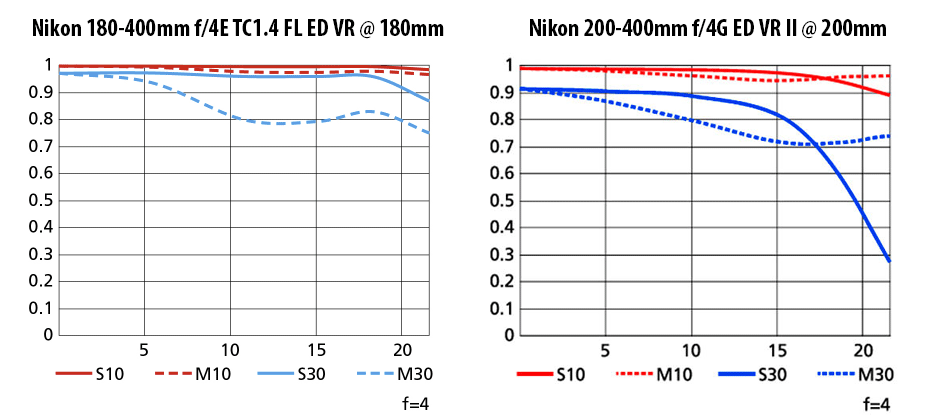
While both MTF charts look phenomenal, it is clear that the Nikon 180-400mm looks superior both in terms of contrast and sharpness levels (note the superior edge performance of the 180-400mm).
Here are both lenses compared at 400mm:
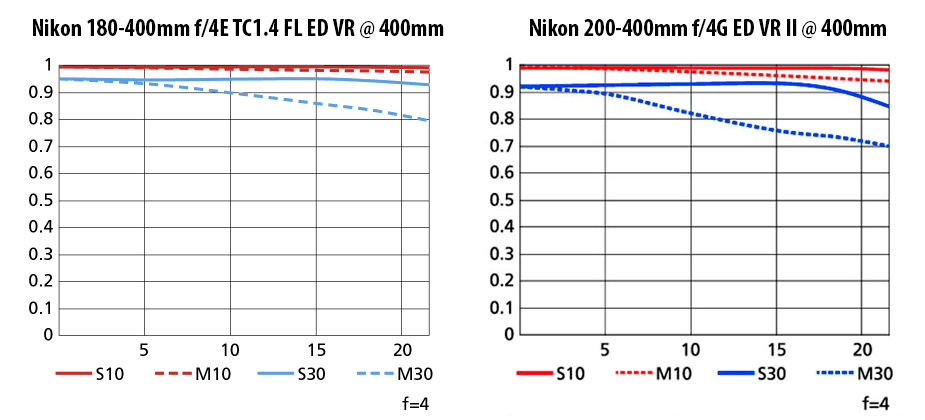
Once again, we can see that Nikon claims the 180-400mm to be noticeably sharper on the telephoto end. On top of that, judging by how close sagittal lines are to meridional, we can expect the lens to yield exceptionally beautiful bokeh, something exotic super telephotos specialize in.
Obviously, these aren’t as flat of MTF curves as we have previously seen on Nikon’s prime super telephotos, but considering that we are looking at a zoom lens, this is pretty darn impressive, to say the least.
You might be wondering why Nikon even bothered including a built-in teleconverter when one can simply attach a 1.4x teleconverter to the lens. The reason why it is always better to have a built-in teleconverter or a teleconverter that is specifically made for the lens is that manufacturers can fine-tune teleconverters with a specific lens to yield the best performance. Since there are manufacturing variances in both lenses and teleconverters, if the two are made for each other specifically, those variances can be minimized. This is why you cannot just go out and purchase a 1.25x teleconverter for the 800mm f/5.6E FL ED VR lens – you won’t find any for sale, since it is only made to couple with the specific 800mm lens it is shipped with.

NIKON D850 + 180-400mm f/4 @ 400mm, ISO 1250, 1/1000, f/4.0
Since teleconverters rob light, contrast, and sharpness from lenses, it is expected that there is going to be a big drop in performance. I wrote about this in great detail in my article on teleconverters.
However, Nikon has been able to minimize sharpness loss with the built-in teleconverter, especially at the long end of the zoom range, as I reveal on the next page of this review. Together with the 1.4x teleconverter, the lens essentially becomes a very versatile 252-560mm f/5.6 lens combo.
Build Quality and Handling
Having owned the Nikon 200-400mm f/4G ED VR II for many years, I have always appreciated the build quality of this lens. I once managed to drop my copy while changing lenses in the field. The drop was not significant – only about a foot, as it slipped out of my hand. My heart almost stopped thinking about potential damage. The lens landed on the attached hood, which didn’t even get a scratch! I mounted the lens on my camera and checked it immediately at different focal lengths (from the center to the extreme corners), and I saw no differences in sharpness. All elements within the lens were intact and didn’t shift in any way (if they did, I would have a decentered lens). Nikon makes sure that these lenses survive the harshest conditions, and the elements inside are always properly secured.

NIKON D850 + 180-400mm f/4 @ 400mm, ISO 400, 1/2000, f/4.0
The Nikon 180-400mm f/4E FL ED VR is not inferior in any way compared to its predecessor – it is built to last for many years. The build quality is as good as it gets for Nikon exotic lenses, starting from the metal barrel, all the way to small details like buttons and switches. Nikon engineers always do a phenomenal job at fine-tuning every aspect of their super-telephoto lenses, and this really shows on the 180-400mm f/4E.
The built-in teleconverter is a critical part of the design of the lens. Since the Nikon TC-14E III by itself weighs around 200 grams, adding it to the 200-400mm setup increased the total weight of the setup to over 3.5 kg. With the addition of three extra elements to the new 180-400mm design, it was supposed to be a heavier lens compared to its predecessor – and that’s without a built-in teleconverter. To address this problem, Nikon engineers first lightened up the lens in the front by replacing a regular lens element with a much lighter fluorite counterpart. This reduced the overall weight of the lens and helped distribute its weight, making it less front-heavy. The added built-in teleconverter was specifically designed for the 180-400mm lens, housing a total of 8 lens elements compared to 7 elements on the TC-14E III. In the end, Nikon was able to squeeze all this technology into the lens while keeping its weight at 3500 grams – an impressive achievement considering that Canon’s 200-400mm f/4L IS USM Extender 1.4x is 120 grams heavier, and has less total elements.
How does the built-in teleconverter work? Since the rear elements of super-telephoto lenses are fairly small, Nikon was able to add the teleconverter element group slightly off to the side of the lens, which added a small bump, as shown below:
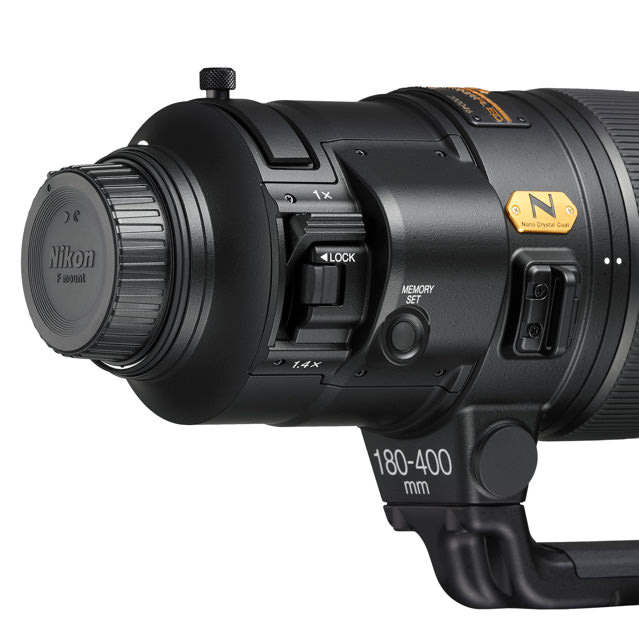
There is a physical lever to the left of the bump, which is what you use to engage or disengage the teleconverter. As you unlock the switch in the middle and flip the lever down, the 8-element 1.4x teleconverter moves into the lens axis. The beauty of this design is that you can do it very quickly with your right hand without taking your eyes off the viewfinder, and this works great during both tripod and hand-held shooting. In comparison, the lever for the teleconverter on the Canon 200-400mm f/4L is located to the left side of the barrel, which makes it very difficult to flip it quickly while hand-holding. You first have to lower the lens, look at it sideways, then lower the lever. These small handling decisions are very important in the field and can mean a world of difference when shooting critical action.

NIKON D850 + 250-550mm f/5.6 @ 450mm, ISO 500, 1/1000, f/5.6
The Nikon 180-400mm f/4E handles beautifully, whether you have it mounted on a gimbal or when you are shooting hand-held. Although 3.5 kilos is a lot of weight to shoot hand-held for prolonged periods of time, I had no problem shooting with the lens for short bursts in the field. John Lawson prefers using the Black Rapid Sling Strap with his 180-400mm lens, which helps quite a bit when he scouts for wildlife. That’s something I personally would recommend as well since it was quite tiring to carry the lens using the tripod foot alone, or on my shoulder when mounted on a tripod.
Speaking of the tripod foot, don’t forget to replace the factory-provided one with an Arca-Swiss version from RRS or Kirk. It still baffles me why Nikon, Canon, and other manufacturers still provide useless tripod feet on these high-end lenses. Arca-Swiss has become a standard in the industry and it makes no sense to continue reusing these ancient tripod feet that cannot be properly mounted on any tripod. I cannot imagine fiddling with flimsy tripod adapters just to be able to mount these lenses, and I am sure manufacturers are well aware of this problem. The last thing you want to do is mount a $12K lens on a $100 tripod setup. While the lens is well-protected against occasional bumps, it might not survive a drop from a tripod, so keep this in mind and invest in a good and stable tripod system.

NIKON D850 + 250-550mm f/5.6 @ 550mm, ISO 900, 1/1000, f/5.6
The side switches are also easy to reach and change when shooting. There are a total of 5 switches on the side: focus mode (A/M, M/A and M positions), focus limiter (full and infinity to 8m), VR mode (off, normal and sport), memory recall (AF-L and AF-ON), and beep (on and off). As with all other Nikon super-telephoto lenses, you have to twist the knob to the side of the filter compartment to unlock it and push it out to clean or change the drop-in filter.
As expected, the zoom ring is very smooth. There are white markings on the top of the zoom ring, indicating 180mm, 200mm, 250mm, 300mm, 350mm and 400mm focal lengths. The zoom ring is relatively easy to reach and adjust, although if you need to quickly go from 180mm to 400mm, you will need to readjust your hand position when hand-holding.
The focus ring is equally smooth and easy to operate, although I personally never liked its placement on this lens, or its predecessor when shooting hand-held. The thing is, with my left palm landing right in the center of the lens, it partially covers the zoom ring, which can sometimes mess up my focusing if I am not careful. I wish Nikon found a way to move the focus ring closer to the front of the lens, or provide an option to disable it completely (it would be great to get an “AF-only” switch) so that one cannot accidentally override the AF.
The function buttons towards the front of the lens barrel are assignable – you can use it to activate AF/AE lock, or switch between different AF Area Modes.
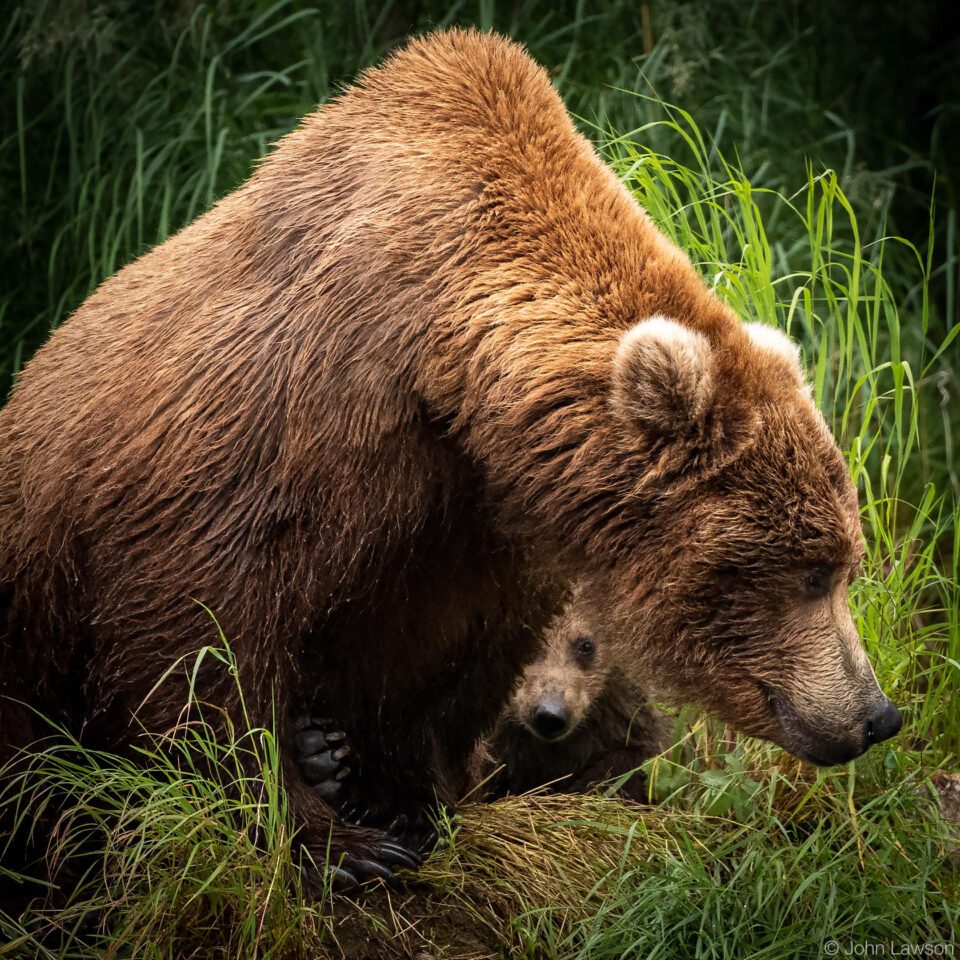
NIKON D850 + 180-400mm f/4 @ 400mm, ISO 1000, 1/1000, f/4.0
Similar to its predecessor, the Nikon 180-400mm f/4E is extensively weather-sealed all around. In addition to 8 different ring-type seals in the barrel, all the lens buttons, switches, and compartments are also sealed with rubber to prevent dust and moisture from getting into the lens. This lens is designed to be used in harsh conditions. If you want to protect your copy against potential scratches, I would recommend getting a LensCoat Lens Cover for it. I have always kept a LensCoat on my 200-400mm, and it certainly did a very good job of not only protecting the lens but also in keeping my hands warm when shooting in colder temperatures.
Autofocus Speed and Accuracy
With the updated Silent Wave Motor (SWM) on the Nikon 180-400mm f/4E, I wondered if there would be any noticeable differences in autofocus performance when compared to the 200-400mm lens. Indeed, Nikon was able to increase the AF speed of the 180-400mm lens, and it is noticeable when comparing it to the older 200-400mm, especially when quickly changing focus from close to faraway subjects.

NIKON D850 + 180-400mm f/4 @ 400mm, ISO 1250, 1/1600, f/4.0
However, the biggest improvement is in autofocus accuracy – that’s where the 180-400mm truly shines! Having owned the 200-400mm f/4G for many years, I have always been frustrated by its tendency to slightly miss focus on subjects when shooting near infinity, yielding relatively soft images. Tuning autofocus accuracy using AF Fine Tune on my cameras was not a great solution either, because parameters differed quite a bit between a close, medium-range, or long-range subject. So when I needed to shoot a bear or a wolf that was far away, I often ended up switching to Live View, zooming in, then manually tweaking focus to get acceptable results. In short, it was a rather frustrating experience.
The first thing I wanted to check with the 180-400mm was focus accuracy. I am happy to report that I did not find any issues with this lens when shooting subjects at close, mid-range, or long-range distances. It seems like Nikon was able to address variances in AF performance, which is great! Autofocusing accuracy is superb, even in low-light environments. This is especially true if you use a modern high-end DSLR with superb low-light AF sensitivity ranges.
Note: Make sure to update the lens firmware to the latest 1.02 version. As detailed on the next page of the review, it is an important update that resolves two serious issues, including AF reliability.
Vibration Reduction
Nikon has updated the VR system on the 180-400mm f/4E with the latest-generation version that is able to provide up to 4 stops of compensation. That’s a noticeable difference when compared to the Nikon 200-400mm f/4G VR II, which only provides up to 3 stops of compensation. While the differences in VR performance are somewhat difficult to quantify, I did notice improvements in stabilization performance while hand-holding when shooting with both lenses side-by-side. It is also easier to frame shots with the new VR system when following fast-moving subjects.

NIKON D850 + 250-550mm f/5.6 @ 550mm, ISO 220, 1/500, f/5.6
In addition, the Nikon 180-400mm f/4E now provides two extra features. It has much better tripod detection (there is no need to turn off VR when shooting from a tripod), and it also provides an additional “SPORT” option on the VR switch for shooting panning action.